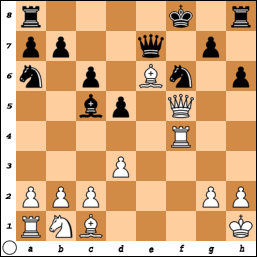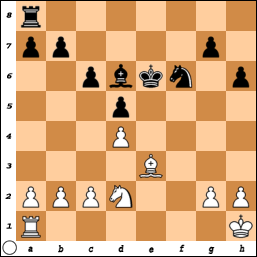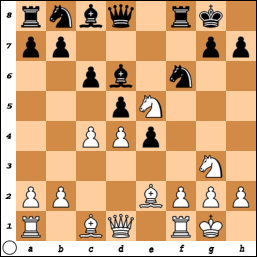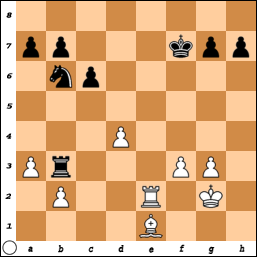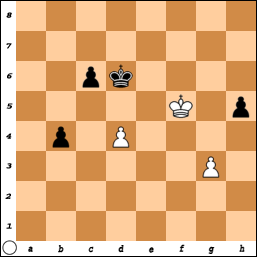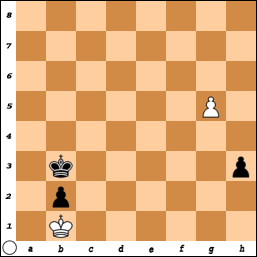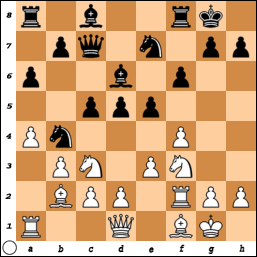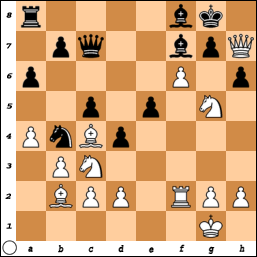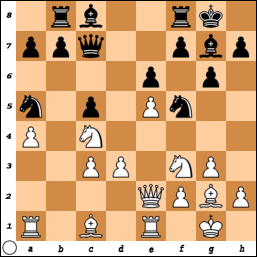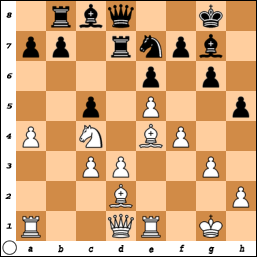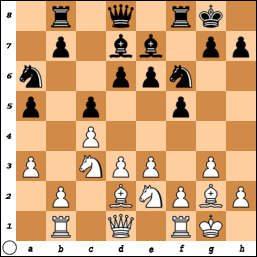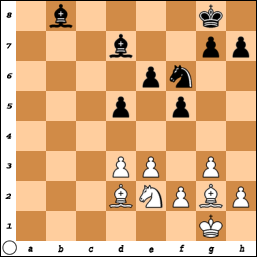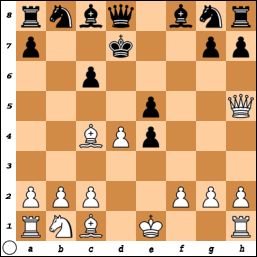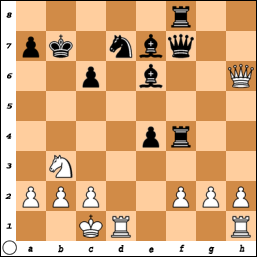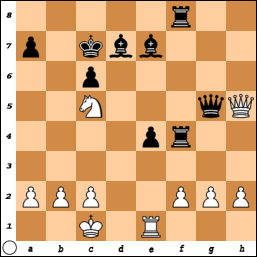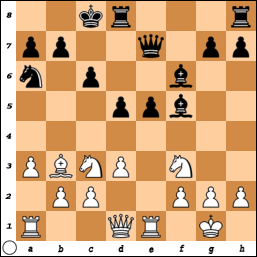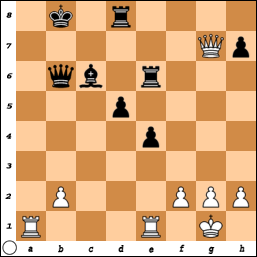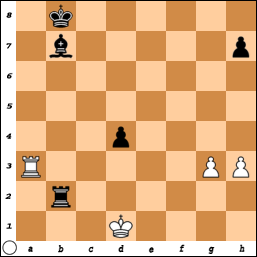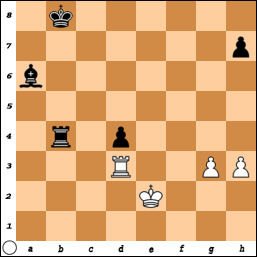[photo by J. Walter Green]
Wednesday, November 30, 2016
Carlsen - Karjakin vs. Spassky - Fischer
Tuesday, November 29, 2016
Marshall Sunday Game/45 11/27/2016
On Sunday, I played these games in the tournament at the Marshall Chess Club.
* * * * * * * *
Round One: Philidor Counter Gambit
Samantha Dong (USCF 1895) - Jim West (USCF 2200), Marshall Chess Club 11/27/2016
1.e4 e5 2.Nf3 d6 3.Bc4 f5 4.d3 c6 5.Qe2 Be7 6.O-O Nf6 7.Ng5 Qc7 8.Bf7+ Kf8 9.exf5 Bxf5 10.f4 exf4 11.Rxf4 h6 12.Ne6+ Bxe6 13.Bxe6 d5 14.Qh5 Bc5+ 15.Kh1 Qe7 16.Qf5 Na6
17.d4 Bd6 18.Rf3 Nc7 19.Re3 Nxe6 20.Rxe6 Qd8 21.Be3 Kf7 22.Qh3 Re8 23.Rxe8 Qxe8 24.Nd2 Qe6 25.Qxe6+ Kxe6, draw.
* * * * * * * *
Round Three: Philidor Counter Gambit
Andrew Zheng (USCF 1796) - Jim West (USCF 2200), Marshall Chess Club 11/27/2016
1.e4 e5 2.Nf3 d6 3.d4 f5 4.Nc3 fxe4 5.Nxe4 d5 6.Ng3 e4 7.Ne5 Nf6 8.Be2 Bd6 9.O-O O-O 10.c4 c6
11.Ng4 Nxg4 12.Bxg4 Bxg4 13.Qxg4 Bxg3 14.hxg3 Qf6 15.Be3 Qf5 16.Qxf5 Rxf5 17.cxd5 Rxd5 18.f3 exf3 19.gxf3 Nd7 20.Rfe1 Re8 21.Bf2 Rxe1+ 22.Rxe1 Kf7 23.Kg2 Ra5 24.a3 Rb5 25.Re2 Rb3 26.Be1 Nb6
27.Kf2 Na4 28.Bb4 Rxb2 29.Rxb2 Nxb2 30.Ke3 Nc4+ 31.Kf4 Nb6 32.Ke5 Nc4+ 33.Ke4 Ke6 34.f4 g6 35.Bf8 h5 36.Bb4 b5 37.Bc5 a5 38.Bf8 Nd6+ 39.Bxd6 Kxd6 40.f5 gxf5+ 41.Kxf5 b4 42.axb4 axb4
43.Ke4 c5 44.Kd3 Kd5 45.dxc5 Kxc5 46.Kc2 Kc4 47.Kb2 b3 48.Kb1 Kc3 49.Kc1 b2+ 50.Kb1 Kb3 51.g4 h4 52.g5 h3, White resigns.
Monday, November 28, 2016
Marshall Saturday Game/60 11/26/2016
On Saturday, I won this game in the tournament at the Marshall Chess Club.
Round Two: Larsen's Opening
Jim West (USCF 2200) - Paris Prestia (USCF 1857), Marshall Chess Club 11/26/2016
1.b3 d5 2.Bb2 c5 3.e3 Nc6 4.f4 Qc7 5.Nf3 f6 6.Bb5 e6 7.O-O Bd6 8.a4 Nge7 9.Nc3 a6 10.Bd3 O-O 11.Rf2 Nb4 12.Bf1 e5
13.fxe5 fxe5 14.e4 d4 15.Bc4+ Kh8 16.Ng5 Bd7 17.Qh5 h6 18.Raf1 Rxf2 19.Rxf2 Nf5 20.Nf7+ Kh7 21.exf5 Be8 22.Qg6+ Kg8 23.f6 Bf8 24.Ng5+ Bf7 25.Qh7#.
Sunday, November 27, 2016
"NY Times": Dead Heat at World Championship
After eleven games, the match between Magnus Carlsen and Sergey Karjakin is in a dead heat.
Saturday, November 26, 2016
Computer Version of QuickChess
[photo by Butler Associates PR]
Friday, November 25, 2016
Donald Trump & World Chess Championship
What does Donald Trump's visit to The New York Times have in common with the reporting of Carlsen"s match versus Karjakin?
Thursday, November 24, 2016
Pix from Marshall November Under 2300
Wednesday, November 23, 2016
"WSJ": First 8 Games of World Championship
By JONATHAN ZALMAN
Nov. 22, 2016 2:59 p.m. ET
14 COMMENTS
The showdown between World Champion Magnus Carlsen and Russian challenger Sergey Karjakin was billed as the most anticipated chess match in decades. Not only would the World Championship take place stateside for the first time in 21 years, it featured a sometimes brash, often charismatic two-time defending champion from Norway versus a defensive-minded underdog.
Who would win this epic battle of East vs. West? For 11 days, the answer to that question was apparently no one.
The pair played to seven straight draws to open their best-of-12 match taking place in lower Manhattan. But on Monday, there was finally a breakthrough.
In Game 8, Karjakin scored the first win and took a big step in his quest to unseat Carlsen. Few anticipated the Russian to be the one to draw first blood, especially while playing with black. “It’s much better to play well than to play white,” he said afterward.
It’s entirely common for chess games of the highest caliber to end in a draw, when both players agree that the position on the board is unwinnable for either side, resulting in a half point for each competitor. And before Karjakin’s win, the streak of seven drawn games to begin a World Chess Championship was nearly a record: In 1995, Garry Kasparov and Viswanathan Anand opened their Classical title match atop the World Trade Center with eight straight draws.
Maybe it’s something in the autumn air of New York City. Or maybe it’s pure mathematics.
In official, head-to-head world chess championships, beginning in 1886, 954 title games have been played, including tie-breaks, with 526 of them resulting in draws, for about a 55% draw rate across various match formats. In Carlsen’s first championship title win in 2013, he drew 70% of his games with Anand, losing none. A year later, Carlsen accomplished a near exact end result, but this time with one loss in the mix.
One main reason for such frequency in draws at the top level is the sheer depth of information available to players—thousands upon thousands of games throughout history whose opening, middle, and endgame patterns and strategies have become cemented into the memories of top grandmasters. Computer technology, of course, has democratized much of this knowledge, which has translated into more objective chess; calculations are precise.
“Chess engines have entered our world—we train with them, we learn from them,” said Susan Polgar, a Hungarian-American grandmaster and coach of the No. 1-ranked college chess team at Webster University in Missouri. “On the opening, sometimes the preparation goes as deep as 20, 25, 30 (moves), or even further.”
Polgar also points to a long set departure from the playing styles of masters from the “Golden Era of Chess,” greats like Paul Morphy and Adolf Anderssen who executed brilliant sacrificial strategies. “The defensive skills are so much more refined now,” she said.
“Chess, by definition, is a drawn game,” said Polgar. “If both sides play perfectly, it’s an equal game. In order for either side to win, the other side must make a big mistake or multiple smaller mistakes. We have perfected the game in a way.”
Neither Carlsen nor Karjakin have thus far played perfectly, and neither player had broken through before Karjakin’s win on Monday night. The people, despite seven hard-fought games, wanteddecisive action and bloodshed, and they got it. Karjakin leads 4.5-3.5, and is two points away from becoming the World Chess Champion.
If you are just bringing yourself up-to-speed, here’s a breakdown of how the first eight matches played out:
Game 1, which took four hours and 42 moves before it was drawn after repetition, was perhaps most notable for Carlsen’s opening attack called the Trompowsky. When asked if there was something behind his choice, as it occurred just three days after the U.S. election, Carlsen said, “I wanted to get an unusual position.” When pressed, and asked if it was perhaps a nod to Donald Trump, Carlsen, joked, “a little bit.” Game 2 lasted three hours and the players agreed to a draw after 33 moves. Essentially, the grandmasters were feeling each other out.
Then, fireworks.
Games 3, 4, and 5 injected the championship with an air of possibility, as both players appeared to have winning chances.
Carlsen had the white pieces in Game 3, a six-hour-plus affair. Here, in the graphic below, is a critical sequence in the match during which Karjakin needlessly pushed his pawn to c5 (move 31), rather than sitting pat in his defensive position, or moving his bishop.
Seeing an opening, Carlsen moved his rook to g8, simultaneously attacking Karjakin’s bishop on f8. The move forced black’s king to protect the bishop and move away from protecting the pawnon f5. With the threat in place, Carlsen retreated his rook back to g2, thereby protecting his pawn on c2, which freed his knight from its job and allowed it to capture black’s pawn on f5. Karjakin then pushed his pawn to d3 to ruin Carlsen’s pawn structure, and Carlsen captured it. Though he increased his edge into the endgame, the World Champion was unable to turn this pawn advantage into a win after 78 moves.
After the game, Carlsen asked his challenger. “Did you see a win for me?”
“No, but it was very close,” said Karjakin.
Game 4 was a torturous, 94-move battle that lasted 6.5 hours. Here, below is a blunder by Karjakin, playing with the white pieces. But for the second straight game, the Russian’s defensive prowess was able to mollify his inaccuracies.
In move 18, Karjakin, playing white, has ideas to destroy Carlsen’s king’s side by capturing a pawn at h6. After Carlsen’s response of Qc6, which protects his knight on f6 and aims to take control of the center, Karjakin ought to have retreated his bishop back to c1. Instead, he took Carlsen’s knight on c4, and exchanged his bishop, which Carlsen took with his pawn. Then, Karjakin finally pulled his bishop back to e3. Despite black’s ruined queen-side pawn structure with doubled up pawns on the c-file, black now has an opening from which to operate and unopposed control of the light squares. But Karjakin’s defense held.
In Game 5, a five-hour-plus affair, Karjakin, playing black, had the opportunity to seize a promising attack but he missed it—and instead chose to play it safe. This was the first time in the match that Carlsen appeared to be in real trouble—here, in the sequence below
After move 43 when Carlsen takes Karjakin’s pawn with Qxd4, Karjakin could have seized the h-file by moving his rook to h8, causing some discomfort to Carlsen’s king. Instead, Karjakin chose the more conservative move of bishop to d5. In doing so, he actually ceded control of the h-file several moves later— Carlsen was able to move his rook to h2 after his king out was safely out of the way on g3. The players agreed to a draw soon thereafter.
After the match, Carlsen was visibly upset with himself. “I screwed up,” he said. “I was lucky not to lose.”
Two lackluster games followed. Karjakin played with white in Game 6, a very quick draw, and Game 7, another drawn contest. After Game 6, a boy in the audience with black circular glasses asked the grandmasters, “When are you expecting your first win?” Both players chuckled and said they didn’t know.
Then came Monday’s pivotal moment.
In Game 8, Karjakin, playing black, and Carlsen dueled to what appeared to be a draw early on. But in the middlegame, both players entered into what Karjakin would later call a “crazy” position. Carlsen would soon push a bit too much, an otherwise signature and effective strategy of his,and both players soon found themselves in a time crunch. Perpetual check was a possibility. But Karjakin kept finding the best moves and eventually his passed pawn on the a-file, compounded by two Carlsen’s errors, was the difference. Karjakin sealed the victory in the endgame with move 52: pawn to a2.
This is a completely lost position for Carlsen. After white’s queen takes the pawn on a2 (Qxa2), Karjakin would then move his knight to g4, putting Carlsen in check. Carlsen is then forced to move his king to h3 (if he moved to h1, it would soon be checkmate). Then, Karjakin brings his queen to g1. From there, Carlsen will be forced to lose his queen, and the game will be over. So after five hours of play and 52 moves, Carlsen resigned.
The showdown between World Champion Magnus Carlsen and Russian challenger Sergey Karjakin was billed as the most anticipated chess match in decades. Not only would the World Championship take place stateside for the first time in 21 years, it featured a sometimes brash, often charismatic two-time defending champion from Norway versus a defensive-minded underdog.
Who would win this epic battle of East vs. West? For 11 days, the answer to that question was apparently no one.
The pair played to seven straight draws to open their best-of-12 match taking place in lower Manhattan. But on Monday, there was finally a breakthrough.
In Game 8, Karjakin scored the first win and took a big step in his quest to unseat Carlsen. Few anticipated the Russian to be the one to draw first blood, especially while playing with black. “It’s much better to play well than to play white,” he said afterward.
It’s entirely common for chess games of the highest caliber to end in a draw, when both players agree that the position on the board is unwinnable for either side, resulting in a half point for each competitor. And before Karjakin’s win, the streak of seven drawn games to begin a World Chess Championship was nearly a record: In 1995, Garry Kasparov and Viswanathan Anand opened their Classical title match atop the World Trade Center with eight straight draws.
Maybe it’s something in the autumn air of New York City. Or maybe it’s pure mathematics.
In official, head-to-head world chess championships, beginning in 1886, 954 title games have been played, including tie-breaks, with 526 of them resulting in draws, for about a 55% draw rate across various match formats. In Carlsen’s first championship title win in 2013, he drew 70% of his games with Anand, losing none. A year later, Carlsen accomplished a near exact end result, but this time with one loss in the mix.
One main reason for such frequency in draws at the top level is the sheer depth of information available to players—thousands upon thousands of games throughout history whose opening, middle, and endgame patterns and strategies have become cemented into the memories of top grandmasters. Computer technology, of course, has democratized much of this knowledge, which has translated into more objective chess; calculations are precise.
“Chess engines have entered our world—we train with them, we learn from them,” said Susan Polgar, a Hungarian-American grandmaster and coach of the No. 1-ranked college chess team at Webster University in Missouri. “On the opening, sometimes the preparation goes as deep as 20, 25, 30 (moves), or even further.”
Polgar also points to a long set departure from the playing styles of masters from the “Golden Era of Chess,” greats like Paul Morphy and Adolf Anderssen who executed brilliant sacrificial strategies. “The defensive skills are so much more refined now,” she said.
“Chess, by definition, is a drawn game,” said Polgar. “If both sides play perfectly, it’s an equal game. In order for either side to win, the other side must make a big mistake or multiple smaller mistakes. We have perfected the game in a way.”
Neither Carlsen nor Karjakin have thus far played perfectly, and neither player had broken through before Karjakin’s win on Monday night. The people, despite seven hard-fought games, wanteddecisive action and bloodshed, and they got it. Karjakin leads 4.5-3.5, and is two points away from becoming the World Chess Champion.
If you are just bringing yourself up-to-speed, here’s a breakdown of how the first eight matches played out:
Game 1, which took four hours and 42 moves before it was drawn after repetition, was perhaps most notable for Carlsen’s opening attack called the Trompowsky. When asked if there was something behind his choice, as it occurred just three days after the U.S. election, Carlsen said, “I wanted to get an unusual position.” When pressed, and asked if it was perhaps a nod to Donald Trump, Carlsen, joked, “a little bit.” Game 2 lasted three hours and the players agreed to a draw after 33 moves. Essentially, the grandmasters were feeling each other out.
Then, fireworks.
Games 3, 4, and 5 injected the championship with an air of possibility, as both players appeared to have winning chances.
Carlsen had the white pieces in Game 3, a six-hour-plus affair. Here, in the graphic below, is a critical sequence in the match during which Karjakin needlessly pushed his pawn to c5 (move 31), rather than sitting pat in his defensive position, or moving his bishop.
Seeing an opening, Carlsen moved his rook to g8, simultaneously attacking Karjakin’s bishop on f8. The move forced black’s king to protect the bishop and move away from protecting the pawnon f5. With the threat in place, Carlsen retreated his rook back to g2, thereby protecting his pawn on c2, which freed his knight from its job and allowed it to capture black’s pawn on f5. Karjakin then pushed his pawn to d3 to ruin Carlsen’s pawn structure, and Carlsen captured it. Though he increased his edge into the endgame, the World Champion was unable to turn this pawn advantage into a win after 78 moves.
After the game, Carlsen asked his challenger. “Did you see a win for me?”
“No, but it was very close,” said Karjakin.
Game 4 was a torturous, 94-move battle that lasted 6.5 hours. Here, below is a blunder by Karjakin, playing with the white pieces. But for the second straight game, the Russian’s defensive prowess was able to mollify his inaccuracies.
In move 18, Karjakin, playing white, has ideas to destroy Carlsen’s king’s side by capturing a pawn at h6. After Carlsen’s response of Qc6, which protects his knight on f6 and aims to take control of the center, Karjakin ought to have retreated his bishop back to c1. Instead, he took Carlsen’s knight on c4, and exchanged his bishop, which Carlsen took with his pawn. Then, Karjakin finally pulled his bishop back to e3. Despite black’s ruined queen-side pawn structure with doubled up pawns on the c-file, black now has an opening from which to operate and unopposed control of the light squares. But Karjakin’s defense held.
In Game 5, a five-hour-plus affair, Karjakin, playing black, had the opportunity to seize a promising attack but he missed it—and instead chose to play it safe. This was the first time in the match that Carlsen appeared to be in real trouble—here, in the sequence below
After move 43 when Carlsen takes Karjakin’s pawn with Qxd4, Karjakin could have seized the h-file by moving his rook to h8, causing some discomfort to Carlsen’s king. Instead, Karjakin chose the more conservative move of bishop to d5. In doing so, he actually ceded control of the h-file several moves later— Carlsen was able to move his rook to h2 after his king out was safely out of the way on g3. The players agreed to a draw soon thereafter.
After the match, Carlsen was visibly upset with himself. “I screwed up,” he said. “I was lucky not to lose.”
Two lackluster games followed. Karjakin played with white in Game 6, a very quick draw, and Game 7, another drawn contest. After Game 6, a boy in the audience with black circular glasses asked the grandmasters, “When are you expecting your first win?” Both players chuckled and said they didn’t know.
Then came Monday’s pivotal moment.
In Game 8, Karjakin, playing black, and Carlsen dueled to what appeared to be a draw early on. But in the middlegame, both players entered into what Karjakin would later call a “crazy” position. Carlsen would soon push a bit too much, an otherwise signature and effective strategy of his,and both players soon found themselves in a time crunch. Perpetual check was a possibility. But Karjakin kept finding the best moves and eventually his passed pawn on the a-file, compounded by two Carlsen’s errors, was the difference. Karjakin sealed the victory in the endgame with move 52: pawn to a2.
This is a completely lost position for Carlsen. After white’s queen takes the pawn on a2 (Qxa2), Karjakin would then move his knight to g4, putting Carlsen in check. Carlsen is then forced to move his king to h3 (if he moved to h1, it would soon be checkmate). Then, Karjakin brings his queen to g1. From there, Carlsen will be forced to lose his queen, and the game will be over. So after five hours of play and 52 moves, Carlsen resigned.
Tuesday, November 22, 2016
Marshall November Under 2300 11/20/2016
This game was played on Sunday in the tournament at the Marshall Chess Club.
Round Four: Sicilian Defense, King's Indian Attack
Jim West (USCF 2206) - Ellen Wang (USCF 1685), Marshall Chess Club 11/20/2016
1.e4 c5 2.Nf3 e6 3.d3 Nc6 4.g3 g6 5.Bg2 Bg7 6.O-O Nge7 7.Nbd2 O-O 8.Re1 d5 9.e5 Qc7 10.Qe2 Nf5 11.c3 d4 12.a4 Rb8 13.Nc4 dxc3 14.bxc3 Na5
15.Nxa5 Qxa5 16.Qc2 Rd8 17.Bg5 Rd7 18.Nd2 h6 19.Nc4 Qc7 20.Bd2 Qd8 21.Be4 Ne7 22.f4 Nd5 23.a5 h5 24.Qd1, draw.
Monday, November 21, 2016
Marshall November Under 2300 11/19/2016
On Saturday, I drew this game in the tournament at the Marshall Chess Club.
Round Two: English Opening
Anthony Wong (USCF 1861) - Jim West (USCF 2206), Marshall Chess Club 11/19/2016
1.c4 e6 2.e3 f5 3.Nc3 Nf6 4.g3 Be7 5.Bg2 O-O 6.Nge2 a5 7.O-O d6 8.d3 Na6 9.a3 Rb8 10.Rb1 c5 11.Bd2 Bd7
12.Na2 b5 13.cxb5 Bxb5 14.Nf4 Bd7 15.b4 axb4 16.axb4 Nxb4 17.Nxb4 cxb4 18.Rxb4 d5 19.Rxb8 Qxb8 20.Qb1 Bd6 21.Ne2 Qxb1 22.Rxb1 Rb8 23.Rxb8+ Bxb8, draw.
Sunday, November 20, 2016
Saturday, November 19, 2016
Friday, November 18, 2016
Thursday, November 17, 2016
Wednesday, November 16, 2016
From Chess.com with Lev
Candidate master Lev Zilbermintz [pictured] won this blitz game in the Newark Gambit variation of the PCG.
Philidor Counter Gambit
Kavalerik (Chess.com 2186) - Lev Zilbermintz (Chess.com 2116), Chess.com 11/5/2016
1.e4 e5 2.Nf3 d6 3.Bc4 f5 4.d4 b5 5.Bxb5+ c6 6.Bc4 fxe4 7.Nxe5 dxe5 8.Qh5+ Kd7
9.Bxg8 Rxg8 10.Qf7+ Be7 11.dxe5 Kc7 12.Bf4 Rf8 13.e6+ Kb7 14.Qxg7 Rxf4 15.Nd2 Bxe6 16.O-O-O Qf8 17.Qxh7 Qf7 18.Qh6 Nd7 19.Nb3 Rf8
20.Rhe1 Qf6 21.Qh5 Qg5 22.Rxd7+ Bxd7 23.Nc5+ Kc7, White resigns.
Philidor Counter Gambit
Kavalerik (Chess.com 2186) - Lev Zilbermintz (Chess.com 2116), Chess.com 11/5/2016
1.e4 e5 2.Nf3 d6 3.Bc4 f5 4.d4 b5 5.Bxb5+ c6 6.Bc4 fxe4 7.Nxe5 dxe5 8.Qh5+ Kd7
9.Bxg8 Rxg8 10.Qf7+ Be7 11.dxe5 Kc7 12.Bf4 Rf8 13.e6+ Kb7 14.Qxg7 Rxf4 15.Nd2 Bxe6 16.O-O-O Qf8 17.Qxh7 Qf7 18.Qh6 Nd7 19.Nb3 Rf8
20.Rhe1 Qf6 21.Qh5 Qg5 22.Rxd7+ Bxd7 23.Nc5+ Kc7, White resigns.
Tuesday, November 15, 2016
Marshall Sunday Game/45 11/13/2016
On Sunday, I played this game in the tournament at the Marshall Chess Club.
Round One: Philidor Counter Gambit
Daniel Ivanov (USCF 1932) - Jim West (USCF 2200), Marshall Chess Club 11/13/2016
1.e4 e5 2.Nf3 d6 3.Bc4 f5 4.d3 c6 5.Nc3 Nf6 6.Bg5 Be7 7.Bb3 Na6 8.Bxf6 Bxf6 9.a3 Qe7 10.exf5 Bxf5 11.O-O O-O-O 12.Re1 d5
13.Na2 Nc5 14.Nb4 a5 15.Nxc6 bxc6 16.Qd2 Qc7 17.d4 Nxb3 18.cxb3 e4 19.Ne5 Bxe5 20.dxe5 Rhe8 21.Rac1 Bd7 22.b4 axb4 23.axb4 Rxe5 24.b5 Re6 25.Qd4 Kb7 26.Ra1 Qb6 27.bxc6+ Bxc6 28.Qxg7+ Kb8
29.Ra3 Bb7 30.Ree3 Rc8 31.h3 Rc1+ 32.Kh2 Qc7+ 33.Qxc7+ Rxc7 34.f3 d4 35.Re1 Rce7 36.fxe4 Rxe4 37.Rd1 Rg7 38.g3 Re2+ 39/Kg1 Rg2+ 40.Kf1 Rf7+ 41.Ke1 Rg1+ 42.Kd2 Rf2+ 43.Kc1 Rxd1+ 44.Kxd1 Rxb2
45.Rd3 Rb4 46.Ke2 Ba6, White resigns.
Subscribe to:
Posts (Atom)

